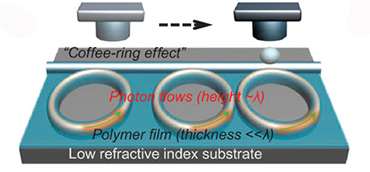
Fabrication of a photonic circuit by confining photon flows in printed structures. Credit: Zhang et al. Sci. Adv., doi: 10.1126/sciadv.1500257
A team of researchers from China reports using a solvent-printing technique to create proof-of-concept soft photonic chips from organic materials (Sci. Adv., doi: 10.1126/sciadv.1500257). The technique could produce photonic integrated circuits for “next-gen” flexible communications, optical storage and optical sensing devices.
Organic materials promise outstanding flexibility and compatibility for photonic integrated circuits (PICs) compared with traditional silicon-based platforms. However, researchers have yet to find a method for large-scale, reproducible organic PIC production like the photolithography techniques used in silicon-based photonics. The team, led by Yong Sheng Zhao and Jiannian Yao from the Institute of Chemistry, Chinese Academy of Sciences, demonstrated a new fabrication technique for organic, flexible PICs by using a solvent to etch microrings and microwires onto polymer layers laid over a substrate.
In one design, they printed a size-tunable polymer microring resonator on a wafer-scale transparent film. Each microring had a radius of about 50 µm, width of 5 µm, and a height of 500 nm. When tested, the flexible resonator exhibited a quality factor of 4.33 x 105, which is comparable to silicon-based counterparts. The researchers also created a low-threshold microlaser by doping the transparent, flexible PIC with organic functional molecules. The resulting chip had a 1-D waveguide and resonator for light signal filtering and optical storage that could, the authors say, be further developed “toward the large-scale on-chip integration of microscopic photonic units.”
The PICs can also be peeled off from the substrate, creating free-standing, flexible chips. The researchers hope that their work will someday lead to large-scale, layered 3-D soft PICs, as well as integration with silicon-based PIC technology.
